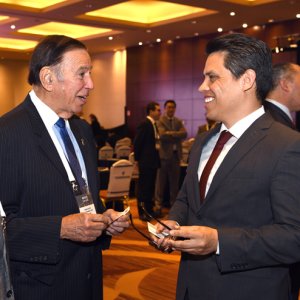
Lack of Exploration Threatens Sustainability
Exploration in Mexico is still attractive but the government must take care to ensure it remains competitive, panelists at Mexico Mining Forum 2017 said on Wednesday in Mexico City, warning that a lack of exploration activity threatened the sustainability of the mining sector.
“Exploration is in crisis,” said Charlie Ronkos, Executive Vice President for Project Development, Americas at Premier Gold Mines. “Exploration looks at cost per ounce of discovery, rather than cost per ounce of ore mined, yet this still has to be competitive with the rest of world. It is important that the cost per ounce in Mexico is very attractive.
The panel at the Hotel Sheraton Maria Isabel debated “A Wealth of Exploration Opportunities” and included Raúl Cruz, Director General of SGM, Robert Scott, CFO of Riverside Resources and Ben Whiting, Vice President Exploration of Orex Minerals. Laura Díaz, Partner at DBR Abogados, moderated.
The current royalty structure poses another hurdle to exploration. “All the indicators show Mexico is a place companies want to invest,” Scott said. “But over the last few years, it has become more difficult to attract investment. As CFO of Riverside, I am spending most of my time trying to manage costs.”
Exploration companies must recover those costs if they are to discover interesting projects. “Because foreign money has no restriction as to where it must be invested, we must be careful to maintain the attractiveness of Mexico as a mining jurisdiction,” he said.
Whiting challenged this sentiment and identified the largest exploration challenge as companies that are unwilling to drill. He used the Boleros silver project in Durango as an example. “We drilled one hole in an area that was never explored before and we discovered 33 million ounces of silver,” he said.
The Orex executive was part of the team that drilled the first hole in what became Coeur Mining’s La Preciosa deposit. “By the time we sold the concession to Coeur Mining, there were 750 drill holes,” he said. He stressed that, although exploration must be carried out in an economic way, the importance of drilling cannot be understated.
Cruz reinforced the opportunities provided by Mexico, especially given the wealth of cartological information offered by SGM. “Mapping began in the 1800s,” he said. “We have now been able to define strong gold and silver belts in Mexico, as well as sizeable deposits of copper, iron and zinc.”
SGM now has over 80 prospects and there are three projects in the pipeline to be tendered by SGM, said Cruz. “These include the Soledad copper deposit in Sinaloa and the Los Borregos manganese/copper deposit in Chihuahua,” he said.
However, while Whiting applauded the work carried out by SGM in its geological database, he challenged the efficiency of the government in presenting mineral concessions for lottery. “At times, that lottery can be carried out three to five years before a piece of ground becomes available for explorers to work on,” he said. “While the database has moved into the 21st century, geological concessions are still struggling.”
Ronkos echoed this sentiment and shared that hurdles must be overcome in obtaining permits in the country. “I have seen examples where it can take two years to drill one hole, which makes it difficult for greenfield projects,” he said. He suggested entering the country as a producer, allowing companies to group together concessions for higher cost efficiency.
Scott disagreed on the solution to this particular challenge. “Things have become more difficult but I would recommend partnerships with strong local groups like Riverside,” he said. “Although Mexico has been able to attract larger and smaller companies, I agree that trying to start greenfield projects can be challenging,” he said.
As a lawyer who deals in these transactions, Díaz agreed that the permit process can be challenging. “For a mining lawyer, this can be the most challenging stage of a project,” she said. “Being present across the entire lifecycle of a mine, from early exploration to closure tests every ability and can make or break a mining lawyer.”
Whiting, however, expressed confidence in Mexican exploration. “Just last month, Riverside announced a new drilling venture in Sonora with one of my companies,” he said. “This will be called Silver Viper Minerals and we plan to drill at the earliest opportunity.”
Likewise, Ronkos is confident about rising metals prices and their impact on the sector as a whole. “I can see a solid future for mining in the next 10 years,” he said.
















